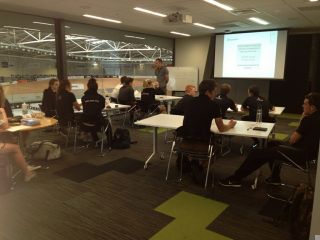Sport and Competition
Facilitating Athlete Readiness
How a coach can enhance athlete preparation.
Posted April 30, 2015
We are all familiar with the traditional coaching approach of performing the motivational and inspiring pre-game speech to work the athletes up to a point where they are ready to run through a brick wall. Today however, it is becoming increasingly acknowledged that athletes have individualised psychological states that, if achieved, will allow them to perform to a high level. Whilst some athletes prefer to get ‘psyched up’ and experience fairly high levels of physiological and psychological arousal, others report preferences for listening to music and engaging in breathing exercises in attempt to compose and manage energy levels. Both of these approaches can be highly effective and it is important to allow scope for both forms of preparation as it is, largely, accepted that being under- or over-aroused can negatively impact performance.
The first step in helping an athlete achieve an optimal mindset for performance is developing an awareness of the unique level of arousal that is likely to support, rather than undermine, their performance. This can be achieved through various questionnaires; however, it can be more simply identified through discussion with the athlete. Asking questions such as “how do you normally feel when you are performing well?”, “looking back to good performances, how did you prepare?”, and “what do you like to be doing in the minutes leading up to a game?”. Such dialogue with an athlete can help both the athlete and coach develop an awareness of the athlete’s preferences (and will likely have an additional positive effect on the coach-athlete relationship).
Once there is an explicit awareness of the optimal level of arousal, the next step is to develop routines and strategies that will allow for an athlete to achieve it. In particular, as coaches, we need to consider our influence (e.g., language, goals, focus, behaviours) on preparing athletes for performance. Quality coaches seem able to facilitate a process that allows athletes to consistently arrive to the start line (tip-off/kick-off) appropriately aroused, experiencing positive nerves, and adequately focused.
When working with teams, I am increasingly seeing athletes being given opportunities to prepare in individual ways. This is, somewhat, easier to do in individual sports, however, with sufficient planning there is scope to allow for this in larger team sports. While there is undoubtedly a need for team-talks and advantages to warming up as a

team, allowing for a degree of ‘free time’ can provide an opportunity for each athlete to go through their own routine. This means that if an athlete recognizes overwhelming levels of anxiety manifesting, there is a chance to, for example, go to a quiet place to stretch and engage in imagery. Such an opportunity may mean that the athlete begins the competition with greater composure and confidence, and as a result can perform more freely,as opposed to being weighed down by anxiety (due to internal and/or external pressure).
In addition to, potential, performance outcomes, allowing athletes to engage in their own preparation will likely have a positive effect on their motivation levels as they experience greater self-determination. Such a coaching approach is likely to support athletes’ essential needs for autonomy (decision making), competence (perception of adequate skill), and relatedness (greater connection with the coach).
Whilst a future post will examine strategies for managing arousal in greater detail, allowing for individual preparation is one of the most effective ways to help athletes begin competition with a level of psychological (nerves, excitement, attentional changes) and physiological (breathing, heart rate, muscular tension) arousal that will facilitate optimal performance.


